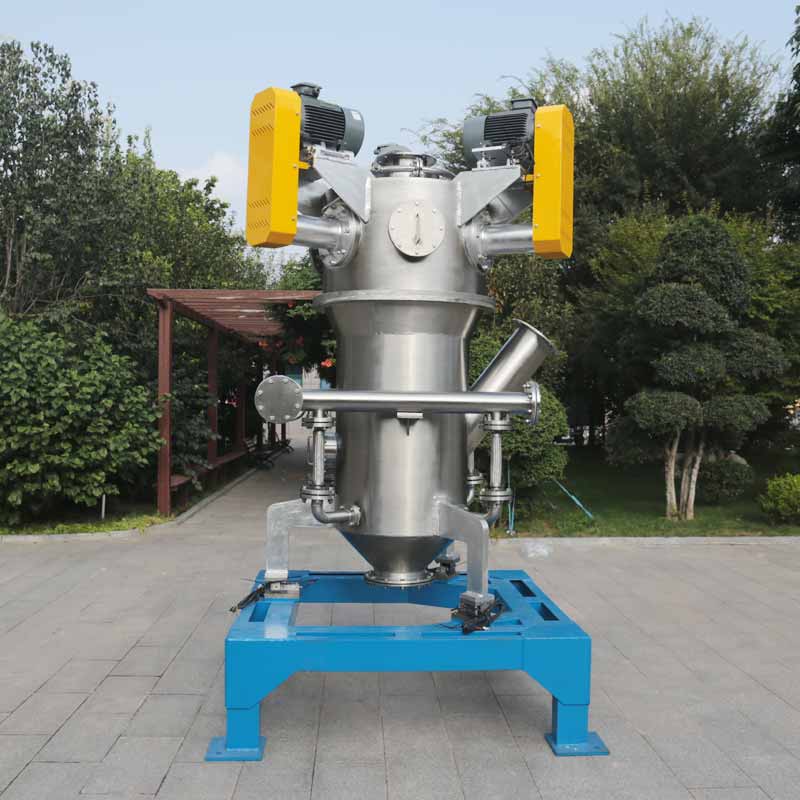How to use and maintain the jet mill
The application of jet mill is very wide, and some matters need to be paid attention to when using, including preparation work and operation process before starting up, maintenance work and so on.
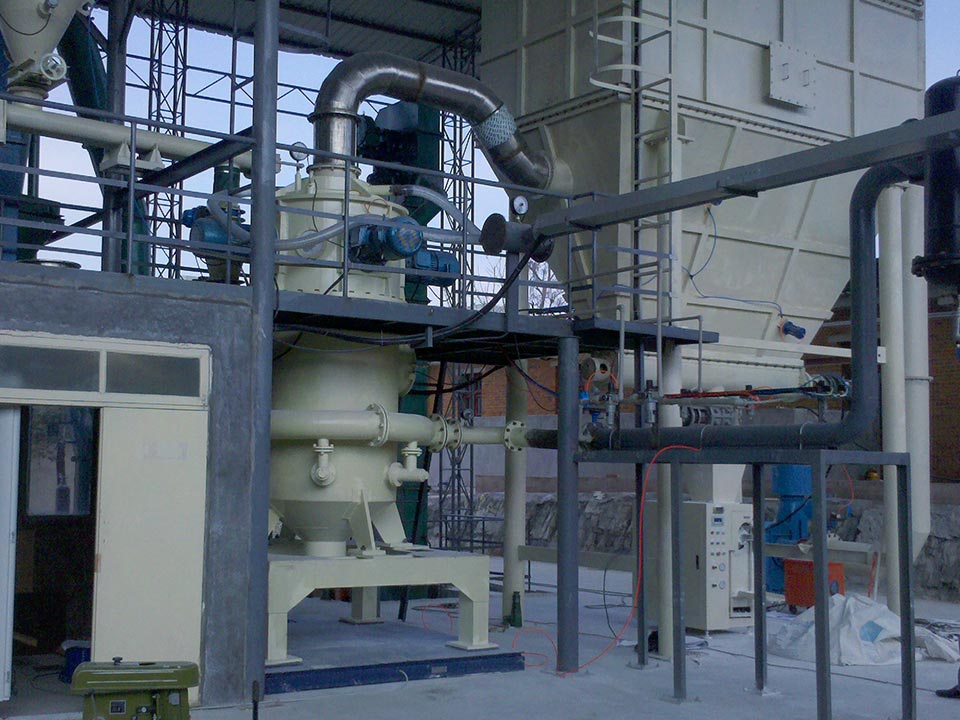
- Preparation before starting
Check whether the host, connecting machine, pipes and valves are in good condition and can work normally.
- Turn on
Boot sequence:
Ensure that the draught fan door is closed, turn on the air compressor, and wait for the compressed air pressure to meet the process requirements. Turn on the sealing gas, turn on the cleaning gas, and turn on the classifier.
Turn on the induced draft fan. After the induced draft fan current drops (40-60 seconds), open the air-regulating door to the opening required by the process. Note that the working current of the induced draft fan motor cannot exceed the rated value.
Turn on the pulse meter, turn on the grinding gas; confirm that the system equipment is working properly, turn on the screw feeder, and add the raw materials. During the production process, raw materials must be supplied and finished products collected in a timely manner.
Shutdown sequence:
Turn off the screw feeder and wait one minute for the next step.
Turn off the grinding gas. Turn off the induced draft fan. Turn off the classifier. Turn off the purge gas. Turn off the sealing gas. Turn off the pulse meter.
- Maintenance
(1) The motor should be lubricated regularly, but the lubricating oil should not be excessive to avoid excessive bearing temperature.
(2) It is important to check the wear of the impeller, screw conveyor and crushing nozzle.
(3) After the material is crushed, the rubber powder in the machine should be cleaned to avoid clogging, thereby affecting the crushing effect.
(4) After a period of use, the filter bag should be cleaned or replaced.
- Matters needing attention
(1) The host equipment and electric control cabinet must be strictly grounded.
(2) The filter element of the dust collector should be in a dry state. If the material discharged by the induced draft fan is found, the filter element should be checked and repaired or replaced in time, and the pneumatic components such as the pulse valve should be checked. If there is a fault, please repair or replace it in time.
(3) The auxiliary air source must be dried and purified to remove moisture and impurities in the air.
(4) Before starting the induced draft fan, the air regulating valve should be closed and fixed. After starting, it should be opened gradually until the required working condition is reached, but the rated current of the motor should not be exceeded.
(5) Before opening the classifier, the sealing gas and cleaning gas must be opened (the pressure of the gas source must be sufficient).
(6) Before starting the machine, check whether there is any debris in the rotor of the grading wheel, and remove it if there is any, so as to prevent the rotor from being unbalanced and damaging the rotor.
(7) The operation room is ventilated, and the operator takes necessary dust-proof measures.
(8) To keep the system unblocked, it is strictly forbidden to block the operation, and regularly check and clean the adhering materials inside the crusher.
Understand lithium carbonate and its applications
Lithium carbonate, an inorganic compound with the chemical formula Li2CO3, is a colorless monoclinic crystal or white powder. Density 2.11g/cm3, soluble in dilute acid, slightly soluble in water, solubility in cold water is greater than hot water, insoluble in alcohol and acetone.
Lithium carbonate is an important source for the preparation of various high-end physical products. According to factors such as processing difficulty, technological level and technical content, it can be divided into basic lithium products and high-end lithium products. Basic lithium products mainly include industrial-grade lithium carbonate and industrial-grade lithium hydroxide; high-end lithium products mainly include battery-grade lithium hydroxide, battery-grade lithium carbonate, pharmaceutical-grade lithium carbonate, and high-purity lithium carbonate.
Raw material of lithium carbonate
There are two main types of lithium in nature. About 70% of the world's lithium exists in salt lakes, and about 30% comes from ore. According to USGS statistics, the world's proven lithium reserves exceed 13.519 million tons (lithium metal); while the resources are as high as 39.78 million tons, equivalent to 210 million tons of lithium carbonate.
Lithium carbonate in the industry mainly refers to lithium ions and lithium ore. Lithium ions mainly exist in salt lake brine, underground brine and sea water. Lithium ore mainly refers to spodumene ore, spodumene, and lepidolite ore. The content of lithium in the earth's crust is about 0.0065%, mainly distributed in South America, North America, Asia, Oceania and Africa.

The top five countries with reserves of lithium resources account for 33.02% in Chile, 18.57% in Bolivia, 13.42% in Argentina, 11.23% in the United States, and 10.52% in China.
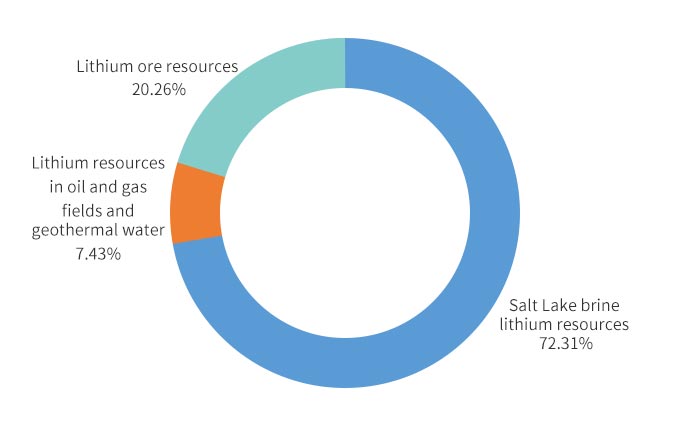
The global output of lithium mines is mainly contributed by Chile and Australia. The output of the two reached 26,300 tons in 2016, accounting for 75.14% of the total global output.
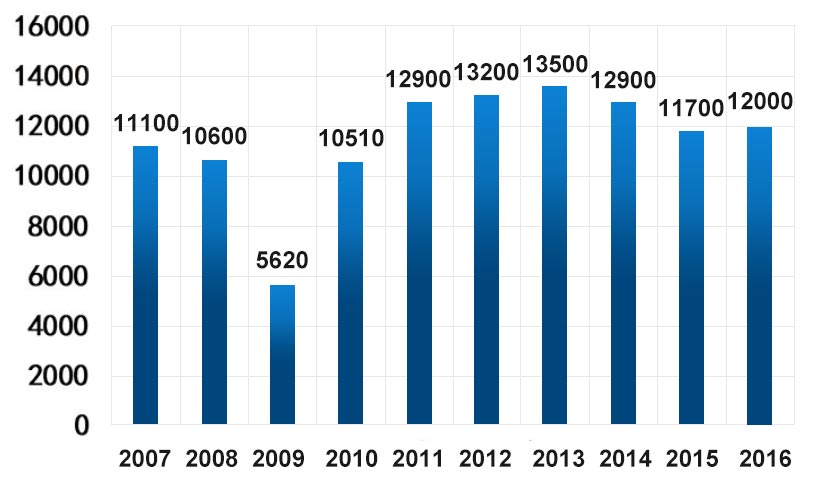
China's lithium production is relatively low, but it is the largest consumer of lithium. It mainly imports most of the required lithium resources from Australia. Australia's lithium mine output in the past ten years is as follows (unit: ton):

According to data released by the U.S. Geological Survey in 2015, China's proven lithium resource reserves account for about 13% of the world's total proven reserves. Among them, salt lake resources account for about 85% of the country's total reserves, and ore resources account for about 15%. China's lithium resources are mainly distributed in Qinghai. Tibet, Xinjiang, Sichuan, Jiangxi, Hunan and other provinces. Tibet and Qinghai are of salt lake brine type, while Xinjiang, Sichuan, Jiangxi and Hunan are of granite pegmatite or granite mineral type.
The preparation methods of lithium carbonate are mainly divided into two categories: ore lithium extraction method and salt lake brine method. Lithium extraction methods from ore mainly include limestone roasting, sulfuric acid method, and sulfate method. Salt lake brine methods mainly include powder adsorption method, solar pond concentration, solvent extraction method, calcining leaching method, and evaporation precipitation method.
Lithium Carbonate Application and Market
- Glass field
In glass manufacturing, lithium carbonate is mainly used in the production process of cathode picture tubes, heat-resistant glass, glass fiber and optical glass. Lithium carbonate can not only reduce the maturation and melting temperature of the glass, increase the density and strength of the glass, but also improve the viscosity and thermal expansion of the glass and many other important properties.

- Ceramics field
In the ceramic manufacturing process, adding an appropriate amount of lithium carbonate can not only increase the transparency and wear resistance of the product, but also reduce the expansion coefficient and melting temperature, thereby reducing fuel consumption and extending the life of the furnace.

- Medicine field
In the field of medicine, lithium carbonate can be used as a sleeping pill and tranquilizer, as well as anorexia nervosa, torticollis, arthritis, epilepsy, etc., and has become the drug of choice for mania.
- Non-ferrous metals
In the aluminum smelting industry, carbon materials containing 0.4% to 1.5% lithium carbonate are used as anodes instead of ordinary activated carbon materials, which can save 300 to 600 kW·h of electricity per ton of aluminum produced.
- Electrode material
Lithium carbonate is the most important product in lithium compounds. It is the main raw material for preparing metal Li, LiOH, LiBr, etc., not only for lithium ion batteries, but also for surface elastic wave component materials, lithium tantalate and lithium niobate.
Lithium carbonate is an indispensable industrial raw material. The downstream applications are: ceramics & glass 31%, batteries 23%, grease 9%, aluminum smelting 6%, refrigerant 6%, castings 4%, rubber 4%, pharmaceuticals 2%, the other 15%.
Article source: China Powder Network
Classification and working principle of jet mill
Jet mill, as one of the ultrafine grinding equipment, is also one of the important equipment in the grinding industry. After the compressed air of the fluidized bed pulverizer is frozen, filtered and dried, it forms a supersonic airflow through the nozzles and is injected into the pulverizing chamber to fluidize the material. The accelerated material merges at the intersection of the jet airflows of several nozzles, resulting in violent The collision, friction and shearing of the particles can achieve ultra-fine grinding of the particles.
The ground material is transported to the impeller classification area by the rising airflow. Under the action of the centrifugal force of the classification wheel and the suction force of the fan, the coarse and fine powder are separated. The airflow enters the cyclone separator, the fine dust is collected by the bag filter, and the purified gas is discharged by the induced draft fan. The flat jet mill has a wide range of applications due to its simple structure and easy manufacturing.
Structure: It is mainly composed of crushing chamber, nozzle opening, discharge opening, air flow outlet, compressed air inlet, classification zone, etc.
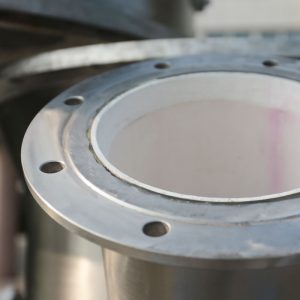
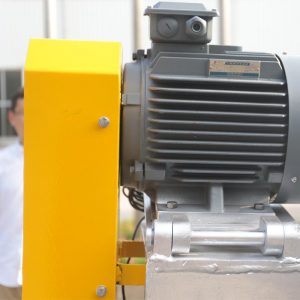
Working principle: The compressed air or superheated steam is transformed into high-speed air flow through the nozzle. When the material is sent into the crushing chamber through the feeder, it is sheared by the high-speed air flow. The strong impact and intense friction make the material grind into ultra-fine products. It is widely used in ultrafine grinding of non-metallic minerals and chemical raw materials. The particle limit of the product depends on the solids content in the confluent gas stream. Under the opposite ratio of unit energy consumption, the products produced by jet mill are more refined, particle size distribution is more uniform, activity is also greater, and the dispersion performance is better than the price. Due to the Joule-Thomson cooling effect caused by the adiabatic expansion of the compressed gas during the grinding process, some low-melting or heat-sensitive materials can be used in the grinding process.
The classification of jet mills currently has the following five types in the industry. They can be divided into horizontal disc (flat) jet mills, circulating tube jet mills, target jet mills, counter jet jet mills and fluidized bed jet mills.
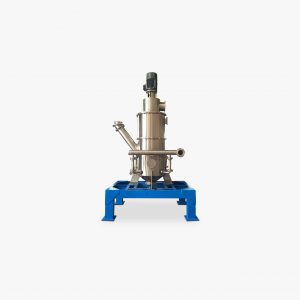
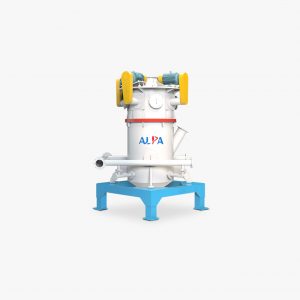
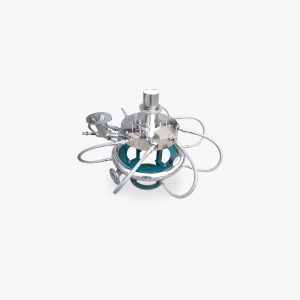
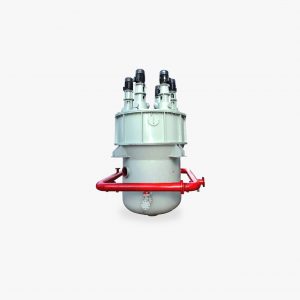
The principle of airflow grinding: dry oil-free compressed airflow or too many nozzles, high-speed jet drives the material to move at a high speed, causing the material to collide, rub and compress. The crushed material reaches the classification area with the airflow, and the material that meets the fineness requirements is finally collected by the collector . If the material does not meet the required particle size, return to the crushing chamber, continue grinding until the required fineness is reached, and stop setting. Due to the high velocity gradient near the nozzle, most of the grinding occurs near the nozzle. In the crushing chamber, the collision frequency of particles and particles is much higher than the collision frequency of particles and the device wall. In other words, the main grinding effect of jet mill is the collision or friction between particles.
Application status and prospect of jet mill
Jet mill, also known as jet mill, refers to the equipment that uses the energy of high-speed airflow (300~500m/s) or superheated steam (300~400℃) to make particles collide, collide and rub each other to achieve ultrafine grinding. Compared with other types of shredders, it has the following advantages:
① Good product granularity. The average particle size (d50) of the material is generally below 5μm, and the particle size distribution is narrow. ②The product has high purity, especially suitable for the grinding of materials that are not allowed to be contaminated, such as medicines. ③It can crush low melting point and heat sensitive materials. ④The product has high particle activity. ⑤The production process is continuous and the production capacity is large.
Jet mills also have some shortcomings, such as: high equipment manufacturing costs, high energy consumption, and large processing costs; single machine processing capacity is poor, not suitable for large-scale production; product particle size is difficult to reach sub-micron level, when it is below 10μm The output has dropped drastically, and the processing cost has risen sharply.
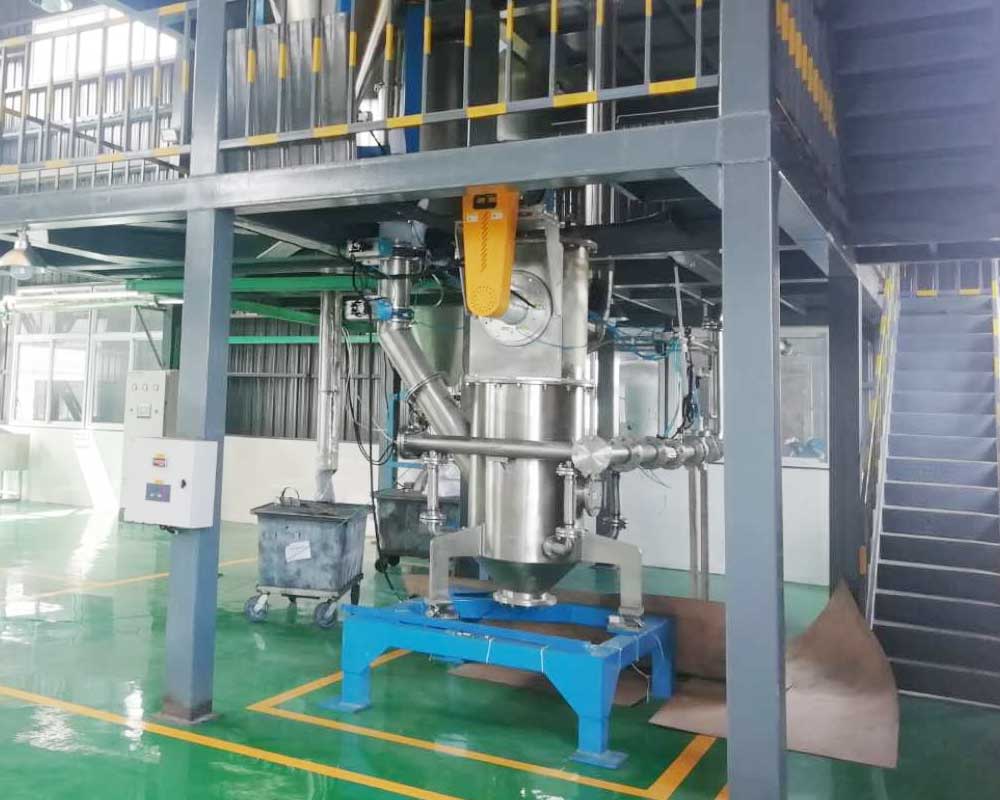
Ultrafine powder technology is an emerging technology. According to the depth of powder processing technology and the changes in powder physical and chemical properties and application performance, the powder with a particle size of less than 10μm is usually called ultrafine powder.
The development of modern engineering technology requires many raw materials and products in powder form. For example, in the military, aerospace, aerospace, and electronic fields, the use of ultrafine powder can be used to make stealth materials; in the chemical industry, the ultrafine catalyst can increase the rate of petroleum cracking by 1 to 5 times; after the ultrafine grinding of drugs, the The surface energy is greatly increased, which improves the effectiveness of the medicine and is beneficial to the absorption of the human body.
Ultra-fine grinding equipment can be divided into different grinding methods: mechanical impact mill, vibration mill, jet mill, stirring mill, etc.
Application status of several ultra-fine jet milling equipment at present
(1) Collision jet mill
This kind of jet milling equipment is also often referred to as a counter-jet jet mill. It uses two high-speed airflows to entrain the particles to be crushed to collide with each other to achieve the grinding effect. It has a high energy utilization rate. It can effectively prevent the jet mill from being damaged due to high-speed impact and can solve the problem of being contaminated by grinding particles.
The advantages of this equipment are mainly reflected in: fast crushing speed, strong impact force, low energy consumption and so on.
(2) Flat jet mill
An early-developed jet mill is a device that uses the collision, shear and friction between particles and the inner wall of the crushing chamber to achieve grinding. Its main component is a disc crushing chamber, several (6-24) high-pressure working fluid nozzles, jet feeders, finished product traps, etc. arranged on the spray ring at a certain angle to the plane of the crushing chamber.
This model is simple in structure, easy to operate, and has a self-classification function, which is especially suitable for the crushing of brittle and soft materials. The outstanding shortcoming is that the grinding cavity is severely worn, which causes certain pollution to the product, and the limit particle size is relatively high.
(3) Fluidized bed jet mill
The working principle of this kind of pulverizing equipment is: adding materials to the pulverizing equipment, using two-dimensional setting of multiple nozzles to spray the impact energy, and the suspension and tumbling collision and friction generated after the expansion of the airflow to achieve the pulverizing effect. The upper airflow near the junction is graded by the grading device at the top under the influence of the negative pressure airflow, and the fine powder is discharged. The coarse powder will be affected by gravity and return to the crushing area to be crushed again.
The advantages of this equipment are mainly reflected in the good dispersion effect, the product size can be adjusted by the classifier, and the wear and energy consumption are relatively small, which is more suitable for large-scale industrial production.
(4) Impact ring jet mill
Replacing the fixed impact component with a rotatable impact ring can avoid the local wear caused by high-speed airflow or gas-solid flow in the previous two types of jet mills under the influence of continuous impact on a fixed position, prompting all positions on the overall ring surface Acting as the impacted surface in turn, the overall annular surface will be subjected to relatively close impact wear, which can promote the life of the impact ring to be extended as much as possible.
The main advantage of this equipment is that the direction of movement of the impact ring is opposite to the jet flow, so the relative speed can be increased, which helps to enhance the grinding effect.
(5) Circulating jet mill
JOM circulating jet mill is mainly composed of O-shaped circulating tube, high-pressure working fluid nozzle, venturi tube and feeding ejector. After the material enters the circulating pipe, the material is ground through friction and collision between the particles and the pipe wall.
Although this model is small in size and large in production capacity, it has serious wear on the pipe wall and is not suitable for grinding materials with high hardness and high purity. It usually requires the use of super hard and high wear-resistant materials (corundum, super hard alloy, etc.) ) As a lining.
The development trend of ultra-fine jet milling equipment in the future
At present, the research and development and manufacturing of ultra-fine jet milling equipment have been greatly developed, and have made important contributions to the powder industry, but there are few large-scale, specialized, high-purity, ultra-fine products that can be produced.
(1) Strengthen basic theoretical research and optimize process flow
Strengthen basic theoretical research to guide independent innovation and development of equipment, and on the basis of existing equipment, vigorously develop research on process optimization and optimize process flow. For mass-produced powders, special models can be developed in a targeted manner.
(2) Increase the output of a single machine and reduce the energy consumption per unit of product
With the increasing market demand for ultrafine powder products, especially the increase in large-scale users and the increasing requirements for product quality stability, the market demand for large-scale equipment continues to rise. Large-scale equipment can more effectively adapt to the development trend of gradual expansion of ultra-fine powder processing, and it also has many advantages such as low energy consumption per unit product, excellent product quality stability, and convenient management.
Performance advantages of metal powder air classifier
Metal powder airflow classifiers are widely used in ore dressing plants. They are combined with ball mills to form a closed loop and split-flow ore sand, or used in gravity concentrators to classify ore and fine mud, and to classify ore slurry and wash ore in the metal beneficiation process. Desliming, dewatering and other operations in operation. The machine has the characteristics of simple structure, reliable work and convenient operation.
The metal powder air classifier is a kind of air classifier. The classifier, cyclone separator, dust collector and induced draft fan form a set of classification system. Under the action of fan suction, the material moves to the classification area at high speed from the lower inlet of the classifier along with the updraft. Under the strong centrifugal force generated by the high-speed rotating classification turbine, the coarse and fine materials are separated, and the fine particles that meet the particle size requirements are classified. The gap between the wheel blades enters the cyclone separator or the dust collector to collect, the coarse particles entrained by the part of the fine particles hit the wall and the speed disappears, and they descend along the cylinder wall to the secondary air outlet. After the strong elutriation of the secondary air, the coarse and fine particles are separated. The particles rise to the classification zone for secondary classification, and the coarse particles fall to the discharge port for discharge.

Performance advantages and characteristics of metal powder air classifier:
The metal powder airflow classifier is a perfect combination of self-split inertial classification technology and centrifugal classification technology. Its core technology has reached the world's advanced level, and its technical performance is greatly improved compared to turbo classifiers.
- Low energy consumption: the same processing capacity, energy consumption is 50% lower than other horizontal and vertical classifiers.
- High efficiency: the same processing capacity, the classification efficiency is 50% higher than other horizontal and vertical classifiers.
- High precision: high grading fineness, completely eliminates oversized particles and sieve residues in the product.
- Low rotation speed: the rotation speed of the classification wheel is 50% lower than other horizontal and vertical classifiers for the same classification particle size. When producing powder with a Mohs hardness of 5, the grading wheel has no wear; when producing powders with a Mohs hardness ≥ 7, the service life of the grading wheel is 5 to 8 times longer than that of other horizontal and vertical types.
- High output: the output of mainframe can reach 50t/h.
- Reasonable structure: a dedicated hierarchical structure can be configured according to different special requirements.
- It can be combined with ball mill, Raymond mill, impact mill, jet mill and other grinding equipment to form a closed circuit or open circuit system.
- Negative pressure production, no dust pollution, excellent environment.
- High degree of automation, strong stability and easy operation. All impeller classifiers at all levels adopt electronic frequency modulation and stepless speed regulation. Electronic control and automatic dust removal are realized in the automatic circulation multi-box dust collection process, which improves the stability of the negative pressure of the whole machine.
How to choose the right impact mill
After the material enters the valve body from the inlet at the bottom of the impact mill valve body, it will be quickly scattered on the rotor by a hammer, spread around the stator, and enter the crushing area composed of the rotor and the stator. The rotor rotates at a high speed and generates a large amount of air vortex. Under the dual action of air vortex and centrifugal force, the materials not only collide with each other, but also shear and grind between the rotor and the stator to achieve ultra-fine crushing of the materials.

The impact mill must be fixed in cement. If the workplace is frequently changed, the shredder and the motor need to be installed on a base made of angle iron, and the power of the two should match. In other words, the power of the diesel engine is slightly greater than that of the shredder, and the grooves of the two pulleys are matched, and the outer ends of the pulleys must be on the same plane. Before operating the pulverizer, please turn the rotor by hand to ensure that the claws, hammers and rotor are flexible and reliable, and check whether there is any collision in the shell. The direction of rotation of the rotor is the same as the arrow of the machine, and the motor and grinder are well lubricated. During the work, please always pay attention to the operation of the crusher and supply materials evenly to avoid blocking the car and prevent long-term overload. If there is vibration, noise, bearing, gas temperature is too high, outward spraying, etc., stop the inspection immediately and continue working after troubleshooting.
Impact mill is a common type of mechanical equipment in the market, and is often used in enterprises. In addition to crushing some dry materials, the mechanical crusher also crushes some oily materials. The crushing of oily materials is still difficult, because as the fineness and temperature increase during the crushing process, the liquid content in the material will continue to increase. Excessive moisture will cause the filter screen to be blocked, and the material cannot be discharged smoothly.
Secondly, choose according to the size of the material that the customer wants to crush. If you only need to pulverize the powder to 20-120 mesh, you can control it through a screen. If you need to crush the material to 80-10000 mesh, use the winnowing type. Choose according to production capacity: The general configuration and description of the crusher have production capacity: kg/hour. Customers should choose the model size according to actual needs. The finer the fineness of the same machine, the lower the output, and the thicker the fineness, the higher the output.
Application field of jet mill
Jet mills are widely used in chemical, mining, abrasives, refractory materials, battery materials, metallurgy, building materials, pharmaceuticals, ceramics, food, pesticides, feed, new materials, environmental protection and other industries and the ultra-fine grinding and dispersing of various dry materials And particle shaping, it has a wide range of uses.
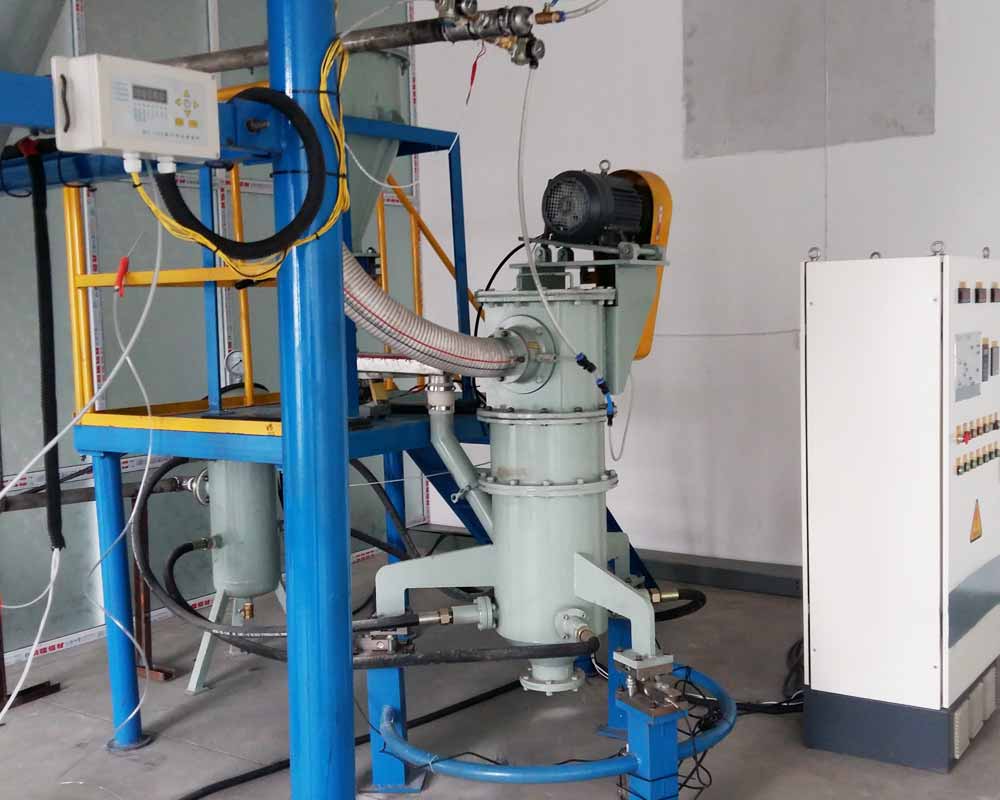
1. Chemical industry:
(1) The ultra-fine catalyst can increase the oil cracking rate by 1 to 5 times;
(2) Chemical fiber, textile, increase smoothness (addition of titanium oxide, silicon oxide);
(3) Rubber, strengthening, lightening, anti-aging (calcium carbonate, titanium oxide);
(4) Coatings, dyes, high adhesion, high performance;
(5) Daily chemical industry, cosmetics, toothpaste, etc.
2. Biology and medicine:
(1) Submicron and nano injections;
(2) Drug refining and enhanced absorption rate (superfine calcium);
(3) Health care products are refined to increase the absorption rate;
3. Military, aviation, electronics, aerospace and other fields:
(1) Super hard, impact-resistant materials, ceramic powder, hard plastics (light weight);
(2) Ultra-fine silicon oxide, high-performance resistance material;
(3) Ultrafine iron oxide powder, high-performance magnetic material;
(4) Ultra-fine oxidizers and explosives, the burning rate is increased by 1 to 10 times;
(5) Superfine graphite, high-performance picture tube and electronic countermeasure materials.
4. Food processing industry:
(1) Fiber food rations, wheat bran, oat hulls, corn germ residue, soybean hulls, rice bran, sugar beet residue and bagasse. After the compressed air of the fluidized bed pulverizer is frozen, filtered and dried, it forms a supersonic airflow through the nozzles and is injected into the pulverizing chamber to fluidize the material. The accelerated material merges at the intersection of the jet airflows of several nozzles, resulting in violent The collision, friction and shearing of the particles can achieve ultra-fine grinding of the particles. The ground material is transported to the impeller classification area by the rising airflow. Under the action of the centrifugal force of the classification wheel and the suction force of the fan, the coarse and fine powder are separated. The coarse powder returns to the crushing chamber according to its own gravity and continues to be crushed. The airflow enters the cyclone collector, the fine dust is collected by the bag filter, and the purified gas is discharged by the induced draft fan.
(2) Micropowders such as calcium supplement foods, animal bones, shells, skins, etc. are easier to be absorbed and utilized by the human body than inorganic calcium;
(3) Chitin, crab shells, shrimp shells, maggots, pupae and other ultra-fine powders. The all-ceramic mechanical crusher is a combination of similar crusher technologies at home and abroad, and has the advantages of impact crushing and hammer crushing. The new type of fine crushing and coarse grinding products developed by optimizing the main technical parameters have the characteristics of large crushing ratio, low energy consumption, stable operation, simple structure, and convenient operation and maintenance. The jet mill is a truly multi-purpose, high-efficiency, low-cost new type of grinding equipment.
(4) Soft drinks can be processed by adopting airflow micro-pulverization technology. It can develop soft drinks such as powdered tea, soybean solid beverages, superfine bone meal, and prepare calcium-rich beverages and instant mung bean flavors.
Application, processing technology and development trend of silicon powder
Silicon micropowder is made of natural quartz (SiO2) or fused quartz (amorphous SiO2 after high temperature melting and cooling of natural quartz) after crushing, ball milling (or vibration, jet milling), flotation, pickling purification, high-purity water treatment, etc. The micro powder processed by this technology.
Silicon micropowder is a non-metallic material that is odorless, non-toxic and non-polluting. It has the advantages of high hardness, low thermal conductivity, high temperature resistance, insulation and stable chemical properties.
According to the level of silicon powder, it can be divided into: ordinary silicon powder, electrical grade silicon powder, fused silicon powder, ultrafine silicon powder, spherical silicon powder. According to the purpose, it can be divided into: fine silicon powder for paint and coating, fine silicon powder for epoxy floor, fine silicon powder for rubber, fine silicon powder for sealant, fine silicon powder for electronic and electrical grade plastics, and fine silicon powder for precision ceramics. According to the production process, it can be divided into: crystalline powder, cristobalite powder, fused powder, and various active powders.
Application of silicon powder
According to its different quality grades, microsilica powder can be used in the production fields of rubber, plastics, advanced paints, coatings, refractory materials, electrical insulation, electronic packaging, high-grade ceramics, precision casting, etc.
Ordinary silicon powder is mainly used for epoxy resin casting paint, potting material, welding rod protective layer, metal casting, ceramics, silicone rubber, ordinary paint, coating and other chemical industry fillers. Electrical grade silicon powder is mainly used for insulation casting of ordinary electrical appliances and components, insulation casting of high-voltage electrical appliances, APG (automatic epoxy resin pressure gel molding technology) process injection material, epoxy potting and high-end ceramic glaze industries.
Electrical and electronic grade silicon powder particle size distribution requirements
| Specification/Mesh | Median particle size D50/μm | Specific surface area/(cm2/g) | Cumulative granularity |
| 300 | 21.00~25.00 | 1700~2100 | ≤50μm≥75% |
| 400 | 16.00~20.00 | 2100~2400 | ≤39μm≥75% |
| 600 | 11.00~15.00 | 2400~3000 | ≤25μm≥75% |
| 1000 | 8.00~10.00 | 3000~4000 | ≤10μm≥65% |
Electronic grade silicon micropowder is mainly used for integrated circuits and electronic components plastic packaging materials and packaging materials, epoxy resin casting materials, potting materials and high-grade paints, coatings, engineering plastics fillers, adhesives, silicone rubber, precision casting , High-grade ceramic glaze fillers and other chemical fields. The annual consumption of epoxy molding compound is tens of thousands of tons, and the content of silica powder in the filler accounts for 70% to 90%.
The SiO2 content of high-purity ultra-fine silicon powder is higher than 99.9%, and it has the characteristics of small particle size, large specific surface area, high chemical purity, and good filling ability. Mainly used for large-scale and ultra-large-scale integrated circuit plastic molding compound, electronic component molding compound, epoxy castable potting compound, high-grade coatings, paints, engineering plastics, adhesives, silicone rubber, precision casting, advanced ceramics and chemicals field.
Spherical silicon powder has a high filling rate, and the smaller the expansion coefficient, the lower the thermal conductivity; the plastic packaging compound has the least stress concentration and the highest strength; the friction coefficient is small, and the wear on the mold is small. Mainly used in electronic plastic packaging materials, coatings, epoxy floors, silicone rubber and other fields.
In order to better fuse non-metallic mineral fillers with high molecular polymers, non-metallic minerals must be crushed, purified and modified. Generally speaking, the smaller the particle size of the filler and the more uniform the dispersion, the better the mechanical properties of the product.
Superfine grinding of silicon powder
The use of natural quartz minerals as raw materials to prepare ultrafine powder is not only to meet market demand, but also to better reduce the content of harmful impurities in the powder. Natural quartz mineral contains a large number of inclusions and cracks. The use of ultra-fine crushing technology can greatly reduce the number of cracks and defects. Combined with the purification process, the content of harmful impurities can be better reduced. The preparation of crystalline powder, cristobalite powder, fusion powder and various active powders requires a grinding and classification process.
The choice of ultra-fine grinding and ultra-fine equipment will directly affect the output, quality and shape of the powder particles of the final product. At present, the unit combinations of ultra-fine grinding and ultra-fine grinding equipment include: ball mill plus grading, eccentric vibration mill plus grading, and vibration mill plus grading.
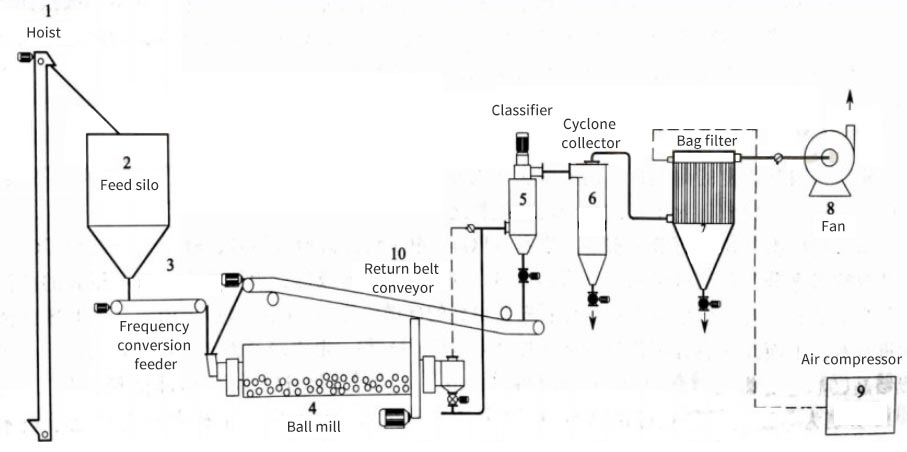
The characteristics of the ball mill classification production line: large output, simple equipment operation, low maintenance costs, flexible selection of grinding media and liners, low pollution to the high-purity processing of materials, reliable overall operation of the equipment, and stable product quality. The application of silicon powder can make the product high in whiteness, good gloss and stable quality index. The production of high-purity ultra-fine silicon powder is obtained by further ultra-fine pulverization or grinding and classification on the basis of the preparation of high-purity sand.
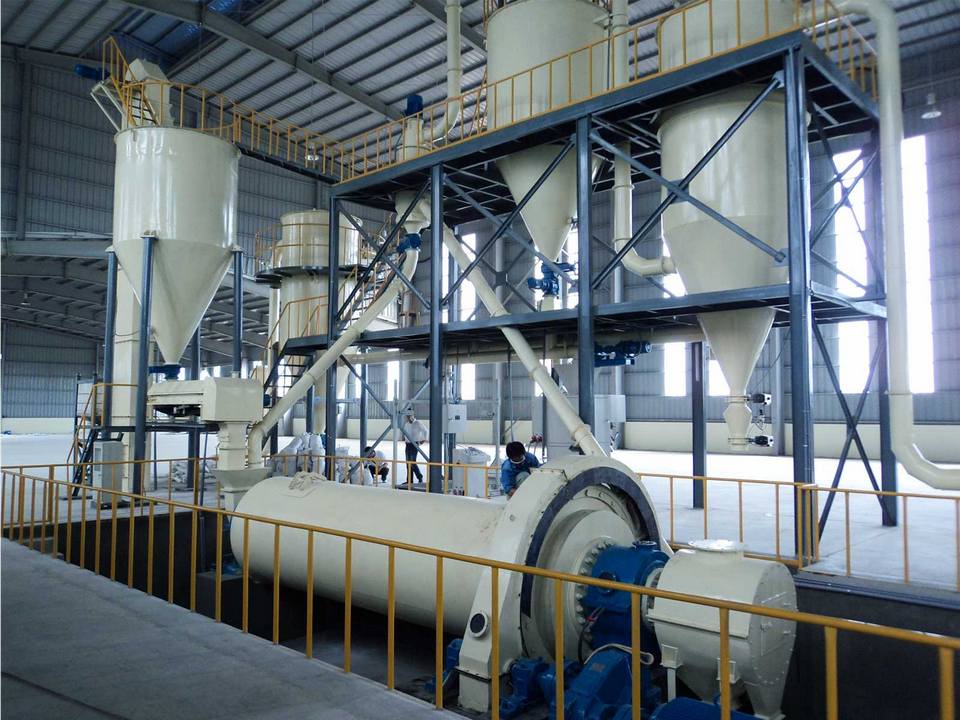
Surface modification of silicon powder
The effect of silane coupling agent applied to the surface modification of silicon powder is very ideal. It can transform the hydrophilicity of silica powder into an organic-philic surface, and can also improve the wettability of organic polymer materials to its powder, and make the silica powder and organic polymer materials realize a strong covalent bond interface through functional groups. .
The application effect of silane coupling agent is related to the selected type, dosage, hydrolysis condition, substrate characteristics, application occasions, methods and conditions of organic polymer materials.
Sphericalization of silica powder
At present, 97% of integrated circuit (IC) packaging materials use epoxy molding compound (EMC), and in the composition of EMC, silicon micropowder is the most used, accounting for 70% to 90% of the mass of epoxy molding compound. Compared with the angular silicon micropowder, the annular silicon micropowder has a higher filling rate, a smaller thermal expansion coefficient, lower thermal conductivity, less stress concentration, higher strength, and better performance of the microelectronic devices produced. Therefore, In addition to high-purity and ultra-fine particles, particle spheroidization has also become one of the development trends of silicon micropowders.
The current methods for preparing spherical silicon powder can be divided into physical methods and chemical methods. The physical methods are: flame balling method, high temperature melting spray method, self-propagating low temperature combustion method, plasma method and high temperature calcining spheroidization. Chemical methods include: gas phase method, hydrothermal synthesis method, sol-gel method, precipitation method, microemulsion method, etc. In chemical methods, due to the serious agglomeration of particles, the larger specific surface area of the product, and the large oil absorption value, it is difficult to mix with epoxy resin when a large amount is filled. Therefore, the current industry mainly adopts physical methods.
Overview of the development of silicon powder industry
The silicon powder industry is a capital, technology, and resource-intensive industry. With the development of high-tech industries, silicon micro-powders have become more widely used and used more and more. The world's demand for high-purity ultra-pure silicon powder will develop rapidly with the development of the IC industry. It is estimated that the world's demand for it will increase at a rate of 20% in the next 10 years. Ultra-fine, high-purity silicon powder has become a hot spot for the development of the industry, spherical silicon powder has become the development direction of the industry, and surface modification technology has been intensified.
Article source: China Powder Network
Advantages and disadvantages of different sealing methods of air classifier
Air classifier is the key to the production of ultrafine powder, because the particle size of the final product is controlled by the classifier. In addition to the cutting particle size, the level of classification efficiency is very important to measure the quality of the air classifier. If the efficiency of the air classifier is high, the quality of the classified products is good, the energy consumption of the grinding operation can also be greatly reduced, and its processing capacity can be significantly improved.
Airflow classifier is a kind of equipment that uses centrifugal force of impeller rotation and drag force generated by airflow to classify materials. The seal between the rotating cage rotor and the stationary shell is an important part of the structure of the vortex air classifier. The failure of the seal is an important reason for the coarsening of the product or the mixing of coarse particles in the finished product.
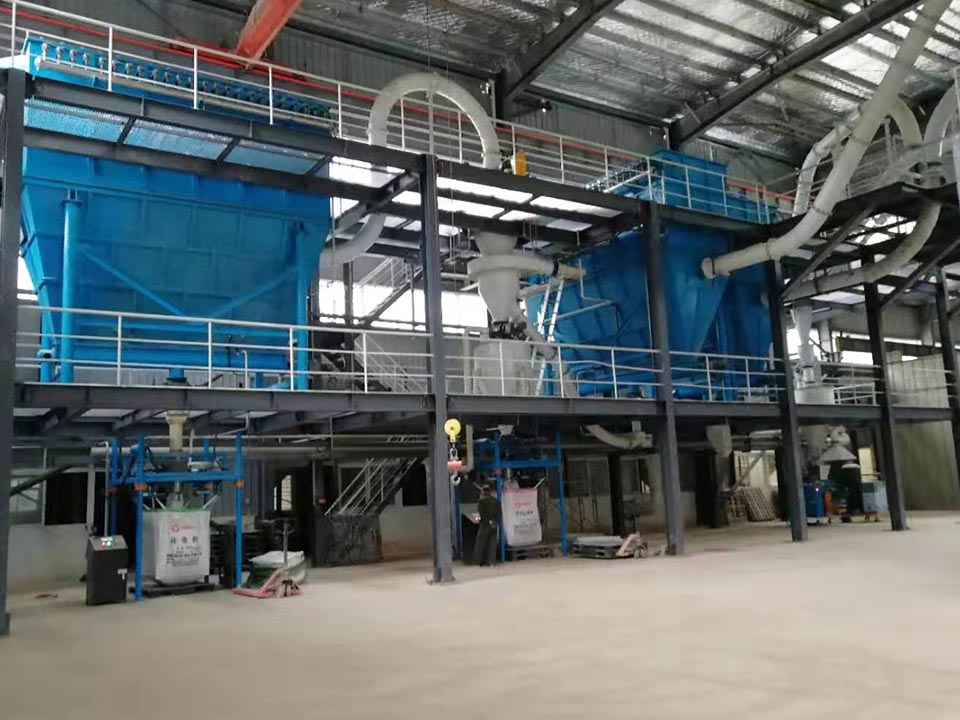
The sealing method of the air classifier:
(1) Airflow sealing
Ordinary turbo classifiers usually use the high-speed rotation of the classifying wheel to prevent particles from rising to the top of the classifying wheel. Theoretically, the sealing effect can be achieved. Most of the domestic horizontal classifiers also use airflow sealing, but the large particles of the classifying wheel cannot be strictly controlled. Leakage, and due to wear and tear, air consumption gradually increases over time.
(2) Mechanical seal
Mechanical seals can be divided into concave-convex mosaic seals, adjustable gap seals and labyrinth seals.
The main principle of the labyrinth seal is to control the sealing gap to ensure the sealing effect, but because the gap always exists, some coarse or even millimeter particles are directly mixed into the finished product without being sorted by the rotor. Therefore, the mechanical labyrinth seal The sealing effect in the superfine class machine is not good.
The differential pressure air classifier adopts a differential air flow sealing structure, which has the characteristics of high classification accuracy, energy saving, high efficiency and low production cost. It has been widely used in the classification and purification process of quartz, feldspar, mica, kaolin, magnesium oxide, etc. .
Application of non-metallic mineral fillers in plastics industry
Non-metallic mineral fillers generally refer to non-metallic mineral materials that exist in nature and are artificially mined, processed and used to have improved strength and various properties, or to reduce costs, and are added to plastics.
Non-metallic mineral fillers are divided into: oxide, hydroxide, carbonate, (sulfite), silicate, carbon, etc. Oxides mainly include: silicon dioxide, diatomaceous earth, aluminum oxide, titanium dioxide, iron oxide, zinc oxide, magnesium oxide, pumice powder, etc. Hydroxides mainly include: aluminum hydroxide, magnesium hydroxide, basic magnesium carbonate and so on. Carbonates mainly include calcium carbonate, magnesium carbonate, dolomite, basic sodium aluminum carbonate and so on. (Sulfite) mainly includes barium sulfate, ammonium sulfate, calcium sulfate, calcium sulfite and so on. Silicates mainly include talc, clay, mica, asbestos, calcium silicate, montmorillonite, bentonite, glass beads, glass fiber, etc. Carbon mainly includes carbon black, graphite, carbon hollow spheres, carbon fiber, etc. In addition, non-metallic mineral fillers include zinc borate, calcium borate, sodium borate, barium metaborate, and potassium titanate.
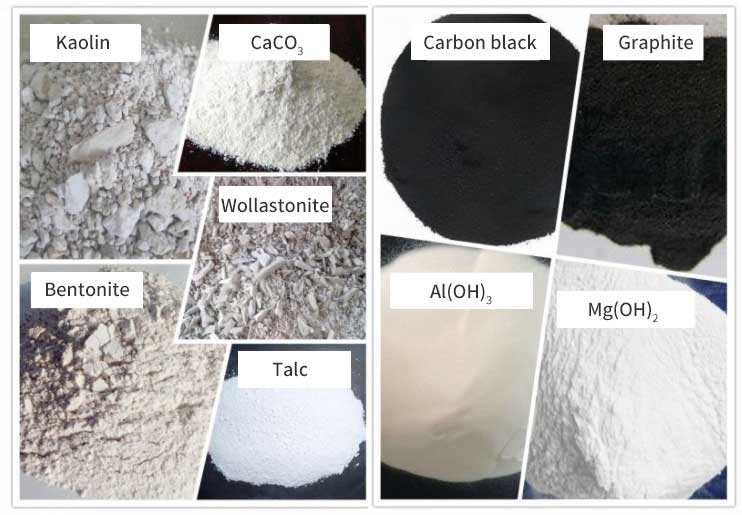
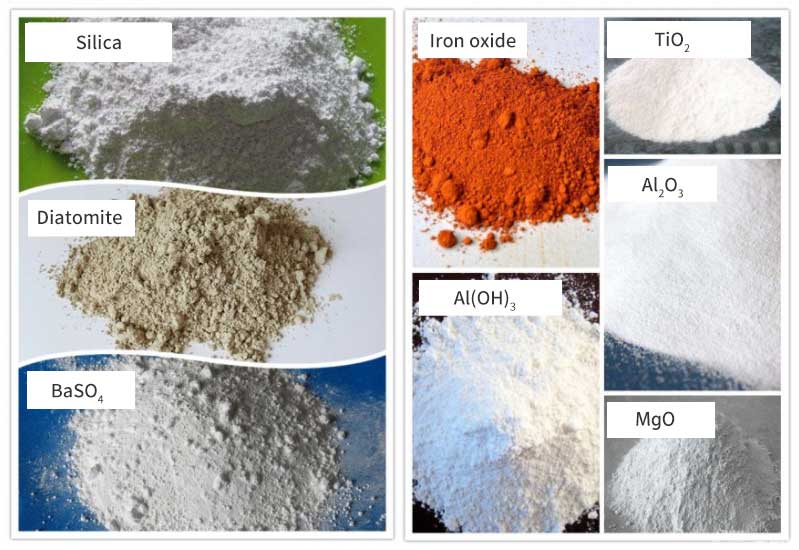
The main modification technologies of non-metallic mineral fillers are: surface chemical modification, surface physical coating, plasma surface treatment, phase solvent treatment, mechanical chemical modification, surface graft modification, precipitation reaction modification, in-situ Polymerization technology.
Physical properties and their effects
Specific surface area: The larger the specific surface area, the better the affinity between the filler and the resin, but the more difficult it is to activate the filler surface and the higher the cost.
Hardness: High hardness can improve the wear resistance of the product, but it will wear the processing equipment.
Color: Most plastic production requires Baidu as high as possible.
Optics: Some products can use their light absorption to increase the temperature, such as: agricultural plastic greenhouses.
Electricity: Condensation or crushing on the surface of the particles causes the valence bonds to be broken and charged, causing uneven particle distribution, which should be avoided in actual production.
Chemical properties and effects
Chemical composition: Affects the corrosion resistance, resin structure and qualitative properties of the product. Different types of fillers have different effects on the product, and different fillers are selected according to the required product characteristics.
Thermochemical effect: High molecular polymers are easy to burn, but most inorganic mineral fillers are added to the polymer matrix to reduce the quality of combustibles and delay basic combustion due to their own inconsistency.
Performance requirements for fillers: high chemical stability, good heat resistance, good dispersion and mixing in plastic resin, small absorption of plastic resin, high purity, insoluble in solvents, good acid and alkali resistance, and no moisture absorption.
The role of fillers in plastics
- Calcium carbonate
Calcium carbonate is currently the most widely used powder filler in the plastics industry. Because of its low price, white color, and good processing performance, heavy calcium carbonate can meet the performance requirements of filled plastics, and its dosage is greatly increased.
- Talcum powder
Talcum powder in plastics can improve the rigidity and heat resistance of plastics, and can increase the light transmittance of film scattering rate in plastics, and has a blocking effect on infrared rays with a wavelength of 7-25μm. It has been used in functional films to improve the nighttime of the greenhouse. Heat preservation and promote the growth of crops.
- Kaolin
Kaolin in PVC cable material can significantly improve the electrical insulation of cable sheath; in plastic film, kaolin has better infrared blocking effect than talc, and is used for agricultural film modification; it is also used for polypropylene to make core Agent to improve its mechanical strength.
- Wollastonite
Wollastonite can be used as a plastic reinforcement, can improve the abrasion resistance and dimensional stability of plastic products, and can improve the flame retardant effect of organic flame retardants.
- Mica
The unique flake structure of mica makes it a typical reinforcing filler in plastics, which is mainly used to improve the rigidity, heat resistance and dimensional stability of plastic products. When mica is used in plastic film, its scattered light transmittance can be greatly improved, which is better than other inorganic fillers.
- Aluminum Hydroxide and Magnesium Hydroxide
Aluminum hydroxide and magnesium hydroxide have the three functions of filling, flame retardant and smoke suppression in plastics; they are also the main additives for PVC conveyor belts used in coal mines, and are often filled with epoxy resin and unsaturated polyester products. Adding agent, the amount can reach more than 40%.
The influence of various fillers on plastic properties
| Performance | Calcium silicate | Mica | Talc | Graphite | Quartz |
| Tensile strength | + | 0 | |||
| Compressive strength | + | + | |||
| Elastic modulus | ++ | ++ | + | + | |
| Impact strength | - | - | - | - | |
| Reduce thermal expansion | + | + | + | + | |
| Reduce shrinkage | + | + | + | + | + |
| Thermal conductivity | + | + | + | + | |
| Thermal stability | + | + | + | ||
| Conductivity | + | ||||
| Electrical insulation | + | ++ | + | ||
| Heat resistance | + | + | + | + | |
| Chemical resistance | + | + | 0 | + | |
| Wear resistance | + | + | + | ||
| Extrusion rate | + | ||||
| Wear to the machine | 0 | 0 | - | ||
| Inexpensiveness | + | + | + | + | ++ |
(++ means high efficiency, + medium efficiency, 0 invalid,-reverse effect)
| Performance | Wollastonite | Clay | Calcium carbonate | Carbon black |
| Tensile strength | + | |||
| Compressive strength | + | |||
| Elastic modulus | + | + | + | |
| Impact strength | - | - | - | - |
| Reduce thermal expansion | + | + | + | + |
| Reduce shrinkage | + | + | + | + |
| Thermal conductivity | + | + | ||
| Thermal stability | + | |||
| Conductivity | + | |||
| Electrical insulation | + | ++ | ||
| Heat resistance | + | + | + | |
| Chemical resistance | + | |||
| Abrasion resistance | + | |||
| Extrusion rate | + | + | ||
| Wear on the machine | 0 | 0 | ||
| Inexpensiveness | + | + | + |
(++ means high efficiency, + medium efficiency, 0 invalid,-reverse effect)
Plastics with non-metallic minerals added
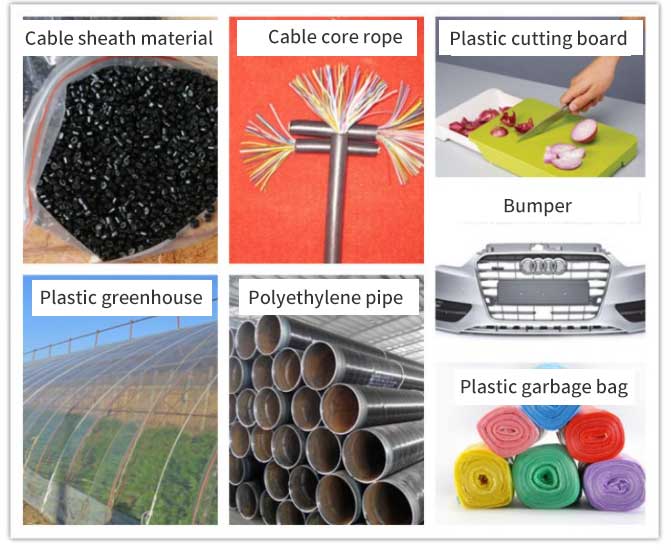
The role of fillers in plastics
Cost reduction: cheap fillers are added to plastics as fillers to reduce costs. Representative examples include the addition of large amounts of calcium carbonate to polyvinyl chloride and polypropylene.
Improve mechanical properties: Compared with polymer resins, non-metallic minerals have higher hardness and modulus, and its active surface can be combined with polymer chains, so the appropriate addition of non-metallic minerals can effectively improve plastic hardness, modulus, strength and other machinery performance.
Enhanced flame-retardant performance: non-metallic minerals have the advantages of good thermal stability, low toxicity or non-toxicity, no corrosive gas, no play during storage, difficult to precipitate, long-lasting flame retardant effect, etc., and they have abundant raw materials and low prices. It is still a simple and effective method to solve the problems of flame retardancy, low smoke and low toxicity of a large number of flammable engineering plastics.
Enhanced stability: Plastics are used in a variety of environments. Non-metallic mineral fillers can enhance the stability of plastics, such as thermal stability, electrical stability, solvent resistance, and light and thermal aging resistance.
Function: After adding most fillers, plastic products have special functions that they did not have before. This is because the chemical composition of the filler plays an important role. For example, adding graphite can increase the conductivity and wear resistance of the plastic.
The use of mineral fillers in plastic products
| Plastic products | Type of filler used | Adding amount (phr) | Effect |
| Polypropylene tape | Calcium carbonate | 10~20 | Increase, whiten, improve printability |
| Polypropylene strapping | Calcium carbonate | 50~150 | Increase and increase the friction coefficient |
| Polyethylene film | Calcium carbonate | 40~50 | Incremental and environmentally friendly |
| Polyethylene pipe | Calcium carbonate | 20~40 | Increment |
| Polyethylene winding pipe, corrugated pipe | Talc | 20~40 | Increase rigidity |
| Polypropylene injection molded products | Calcium carbonate,talcum powder | 40~50 | Replace ABS, reduce costs |
| Polyethylene Greenhouse Film | Talc, Kaolin | 5~10 | Improve heat preservation |
| Polyethylene garbage bag | Calcium carbonate | 40~50 | Improve incineration |
| Polypropylene snack tray | Calcium carbonate | 200 | Reduce costs and improve stability |
| Bumper | Talc | 20~30 | Maintain rigidity and improve impact resistance |
| Automobile and home appliance parts | Talc | 30~50 | Improve heat resistance |
| PVC doors and windows profiled materials | Calcium carbonate | 10 | Improve toughness and forming processability |
| PVC pipe | Calcium carbonate | 20~60 | Reduce costs |
| PVC foam material | Calcium carbonate | 30~80 | Reduce costs and improve uniformity |
| PVC decorative board | Calcium carbonate | 200 | Reduce costs |
| Cable sheath material | Calcium carbonate | 10~15 | Reduce costs |
| PVC artificial leather | Calcium carbonate | 10~60 | Increment, reduce costs |
| Power cable core rope | Calcium carbonate | 180~200 | Reduce costs |
| High insulation power cable sheath material | Calcined kaolin | 10~15 | Improve electrical insulation strength |
| High gloss polypropylene | Precipitated barium sulfate | 40~50 | Maintain the gloss of the plastic surface |
| Halogen-free low-smoke cable sheath material | Aluminum hydroxide, magnesium hydroxide | 150 | Flame retardant, smoke suppression |
| Motor fan blades for automobiles, etc. | Mica | 40~50 | Improve heat resistance |
| Cases and parts of air conditioners, televisions, etc. | Calcium carbonate, talcum powder | 40~60 | Reduce costs and improve dimensional stability |
The main motivation for using mineral fillers is to reduce the cost of raw materials for plastic products, so price is the primary influencing factor. Coarse particle size fillers tend to be cheaper than fine particle size fillers. Not all plastic products are suitable for the use of mineral fillers. Some are not suitable for use, such as transparent products; some are due to the problems caused by the use of mineral fillers, such as weight gain and poor coloring.
The smaller the particle size of the non-metallic mineral filler, the better the physical and mechanical properties of the filled plastic when used properly. However, within the range allowed by the current technical level and equipment conditions, the particle size is too small, but it is not easy to use, not only the price is high It also affects the fluidity of the molding process and the mechanical properties of the filling material.
More and more attention has been paid to the functionality of non-metallic mineral fillers. Therefore, when developing new varieties of mineral fillers, we must first consider what new functions it can bring to plastic materials.
Article source: China Powder Network

